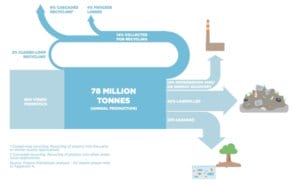
There are a lot of figures to digest. Maybe this infographic courtesy of plastic oceans.org will help.
It’s been simmering in the background for decades and is one of the most serious problems facing humanity today. Third World famine and atrocities in the name of religion quite rightly get all the headlines but now, finally, the global plastic waste problem is starting to get noticed by the right people and it’s beginning to make headlines but are we too late to stop a plastic catastrophe in our oceans?
The convenience food boom of the 1980’s kick started a generation growing up on microwave meals and cheap pre packed convenience foods that we all now take for granted but along with the convenience came the packaging. An awful lot of needless packaging that ends up in landfill. Hundreds of thousands of tonnes every year globally while currently only 14% of plastic packaging is recycled.
The plastic bottle is a marvel of modern industrial design; its reusable and recyclable but most of the time the bottle will end up in the bin. Some governments have got a lot better at recycling the waste they receive but in a lot of less developed countries recycling is still not the norm and the bottle will end up in the local landfill or tossed out on the street. According to plasticoceans.org, a global network of independent not-for-profit and charitable organisations, a water bottle will take 400 years to break down in water and beverage containers make up 14% of all plastic waste worldwide. The figure rises when you factor in the caps and labels. If that sounds frightening, it should be!
As travellers, bottled water is the easiest way we can make a huge impact on reducing the plastic waste we leave in the countries that we visit. We can, and should, all do our bit by avoiding buying water bottles where at all possible. If you have to use one keep it to use another time or make sure it goes in the recycling when you’re finished; even if that means you have to bring the empty bottle home with you.
When I’m travelling I always take a sturdy water bottle with me in the form of a Water To Go bottle. With an in-built carbon filter that kills 99.9% of germs, I can drink water from any fresh water source without the worry of getting ill; even in countries that advise against drinking the tap water.
 Conservation organisations are beginning to tackle the issue with the companies that will have the biggest impact. According to a Greenpeace survey, 2 million tonnes of throwaway plastic is produced yearly by 5 of the top 6 beverage manufacturers. Only a tiny proportion of these bottles currently are made from recycled plastic. Coca Cola, the largest beverage manufacturer in the world, didn’t provide figures for the survey but analysts believe, based on a mix of sales and market share data freely available in the company reports, that Coca Coca produces in the region of 108-128 billion single use plastic bottles every year.
Conservation organisations are beginning to tackle the issue with the companies that will have the biggest impact. According to a Greenpeace survey, 2 million tonnes of throwaway plastic is produced yearly by 5 of the top 6 beverage manufacturers. Only a tiny proportion of these bottles currently are made from recycled plastic. Coca Cola, the largest beverage manufacturer in the world, didn’t provide figures for the survey but analysts believe, based on a mix of sales and market share data freely available in the company reports, that Coca Coca produces in the region of 108-128 billion single use plastic bottles every year.
There could be a promising answer to single use plastic bottles. You may even have come across it at one of many events they have been prominent at in London, Boston and San Francisco over the last few months even though the product isn’t available commercially yet. A small startup called Ooho! by Skipping Rocks Lab has produced an edible alternative to the water bottle made from plants and seaweed. It’s 100% biodegradable and does so in 4-6 weeks, just like a piece of fruit. Its cheaper to produce than a plastic bottle because it takes 5 times less carbon dioxide and 9 times less energy. They are one of many companies that are taking an exciting leap into a new world of edible containers.
Our dependence on plastic over the past 30 something years has got to stop. A frighteningly well written post on this issue from Wendy at Its A Fish Thing makes for some very sobering reading. If we do nothing about the vast amount of plastic we produce and then don’t recycle we stand to have our oceans filled with more plastic than fish by 2050 according to a study by the Ellen Macarthur Foundation. If we don’t change our attitudes to the convenience lifestyle that we have all become so accustomed to over the last 30 years we risk leaving future generations with a plastic filled ocean that is too dangerous to go near and that is a very frightening thought.
 Copyright secured by Digiprove © 2017
Copyright secured by Digiprove © 2017



